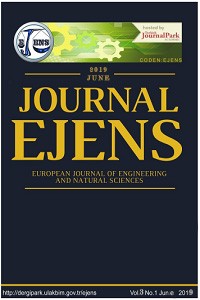Investigation of Heat Transfer from Heated Square Patterned Surfaces in a Rectangular Channel with an Air Jet Impingement
Abstract
Heat
transfer is a very important precaution for proper design and safe operation of
electronic packages and systems. Impinging jets are usually used to solve
thermal problems of electronic components in industry due to providing a good
heat transfer performance. In this study, cooling of copper plate with five
square patterned surfaces inside a rectangular channel comprising of one open and three blocked sides was
numerically investigated by using a single air jet flow. The numerical
computations were performed by solving a steady, three-dimensional
Navier-Stokes equation and an energy equation by using Ansys-Fluent 17.0
software program with k-ε turbulance model. Air was taken as working fluid with
inlet temperature of 300 K. A constant heat flux with 1000 W/m2 was
applied to square patterned surfaces while the top and side surfaces were
adiabatic. The study was carried out for different Reynolds numbers (Re) of
4000, 6000, 8000 and 10000 and different jet-to-plate distances (H/Dh)
of 4, 6, 10 and 12. The numerical results agreed well with the numerical and
experimental datas of study existed in literature. The results were presented
as the variations of the mean Nu numbers and temperatures for each square
patterned indentation surface. The temperature and velocity distributions of
jet fluid flow and mean temperature and Nu values of whole five square
patterned surfaces and value of air jet outlet temperature were also researched
for different Re numbers and H/Dh ratios. It was seen that
increasing the Re number increases the Nusselt number for all cases. Average
Nusselt number increases of 59.28% from Re=4000 to Re=10000 for H/Dh=4.
However, Nu number was less sensitive to H/Dh ratio in the range of
H/Dh=4-12. Average Nusselt number decreases of 9.11% from H/Dh=4
to H/Dh=12 for Re=6000. The highest average Nusselt number was
attained for Re=10000 and H/Dh =6.
References
- B. W. Webb and C. Ma, “Single-phase liquid jet impingement heat transfer”, Adv. Heat Transf., vol. 26 pp. 105–117, 1995.
- G. M. Carlomagno and A. Ianiro, “Thermo-fluid-dynamics of submerged jets impinging at short nozzle-to-plate distance: a review”. Exp Thermal Fluid Sci., vol. 58, pp. 15–35, 2014.
- E. Argus, M. A. Rady and S. A. Nada, “A numerical investigation and parametric study of cooling an array of multiple protruding heat sources by a laminar slot air jet”. Int J Heat Mass Transf., vol. 28, pp. 787–805, 2006.
- M. Popovac and K. Hanjalic K, “Large-eddy simulation of flow over a jet-impinged wall-mounted cube in a cross stream”, Int J Heat Fluid Flow, vol. 28, pp. 1360–1378, 2007.
- Y. T. Yang, C. H. Hwang, “Numerical simulations on the hydrodynamics of a turbulent slot jet on a semi-cylindrical convex surface”, Num Heat Transfer, vol. 46, pp. 995–1008, 2004.
- K. S. Mushatat, “Analysis of the turbulent flow and heat transfer of the impingement cooling in a channel with cross flow”, Eng Sci, vol. 18, pp. 101–122, 2007.
- N. Zuckerman and N. Lior, “Jet impingement heat transfer: physics, correlations, and numerical modeling”, Adv. Heat Transf., vol. 39, pp. 565–631, 2006.
- FLUENT User's Guide, Fluent Inc. Lebanon, NH, 2003.
- M. Kilic, T. Calisir, S. Baskaya, “Experimental and numerical study of heat transfer from a heated flat plate in a rectangular channel with an impinging air jet”, J Braz. Soc. Mech. Sci. Eng., vol. 39, pp. 329-344, 2017.
Abstract
References
- B. W. Webb and C. Ma, “Single-phase liquid jet impingement heat transfer”, Adv. Heat Transf., vol. 26 pp. 105–117, 1995.
- G. M. Carlomagno and A. Ianiro, “Thermo-fluid-dynamics of submerged jets impinging at short nozzle-to-plate distance: a review”. Exp Thermal Fluid Sci., vol. 58, pp. 15–35, 2014.
- E. Argus, M. A. Rady and S. A. Nada, “A numerical investigation and parametric study of cooling an array of multiple protruding heat sources by a laminar slot air jet”. Int J Heat Mass Transf., vol. 28, pp. 787–805, 2006.
- M. Popovac and K. Hanjalic K, “Large-eddy simulation of flow over a jet-impinged wall-mounted cube in a cross stream”, Int J Heat Fluid Flow, vol. 28, pp. 1360–1378, 2007.
- Y. T. Yang, C. H. Hwang, “Numerical simulations on the hydrodynamics of a turbulent slot jet on a semi-cylindrical convex surface”, Num Heat Transfer, vol. 46, pp. 995–1008, 2004.
- K. S. Mushatat, “Analysis of the turbulent flow and heat transfer of the impingement cooling in a channel with cross flow”, Eng Sci, vol. 18, pp. 101–122, 2007.
- N. Zuckerman and N. Lior, “Jet impingement heat transfer: physics, correlations, and numerical modeling”, Adv. Heat Transf., vol. 39, pp. 565–631, 2006.
- FLUENT User's Guide, Fluent Inc. Lebanon, NH, 2003.
- M. Kilic, T. Calisir, S. Baskaya, “Experimental and numerical study of heat transfer from a heated flat plate in a rectangular channel with an impinging air jet”, J Braz. Soc. Mech. Sci. Eng., vol. 39, pp. 329-344, 2017.
Details
| Primary Language | English |
|---|---|
| Journal Section | Makaleler |
| Authors | |
| Publication Date | June 27, 2019 |
| Published in Issue | Year 2019 Volume: 3 Issue: 1 |

